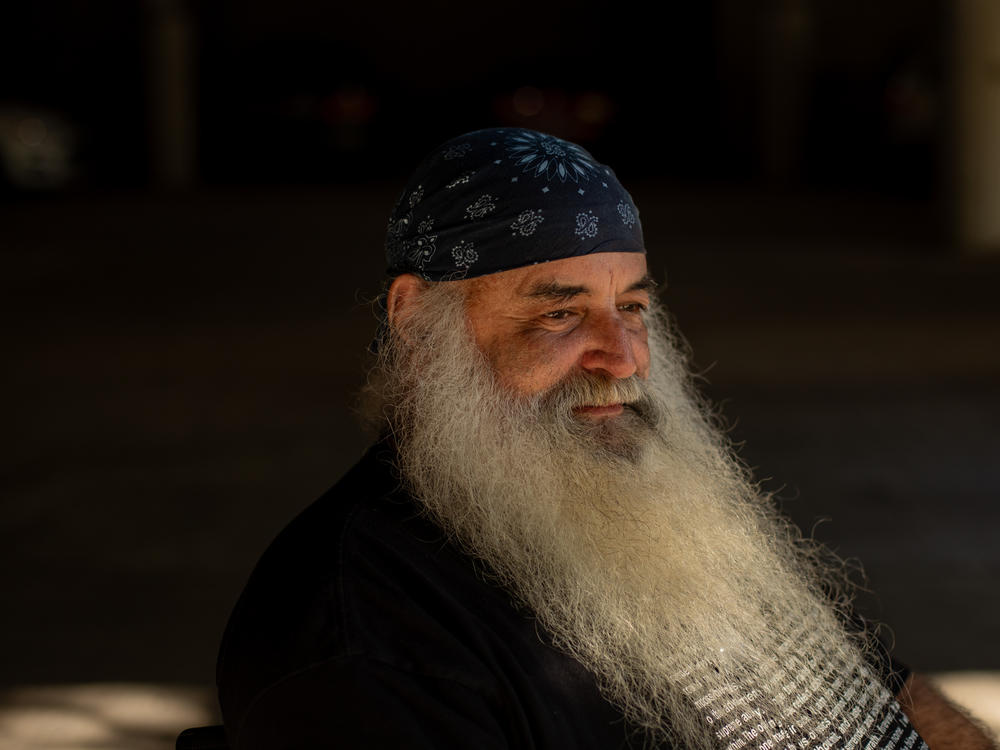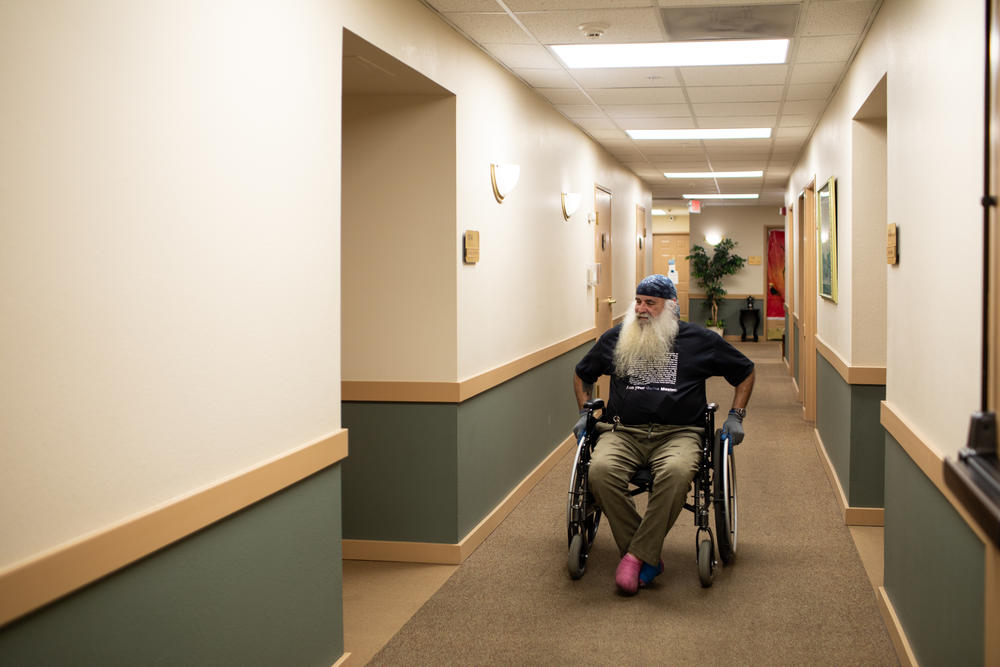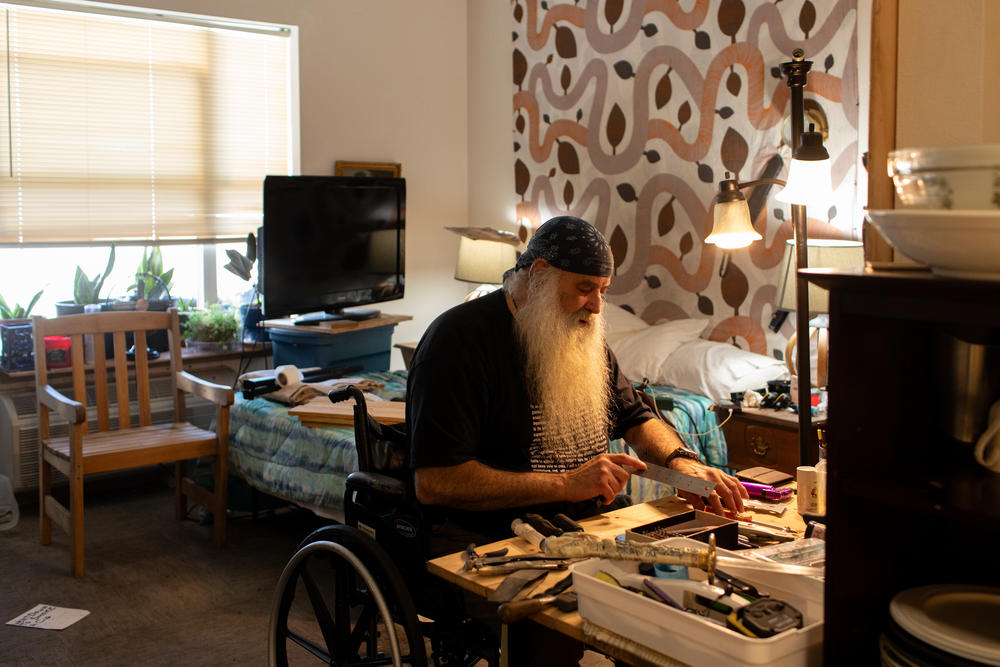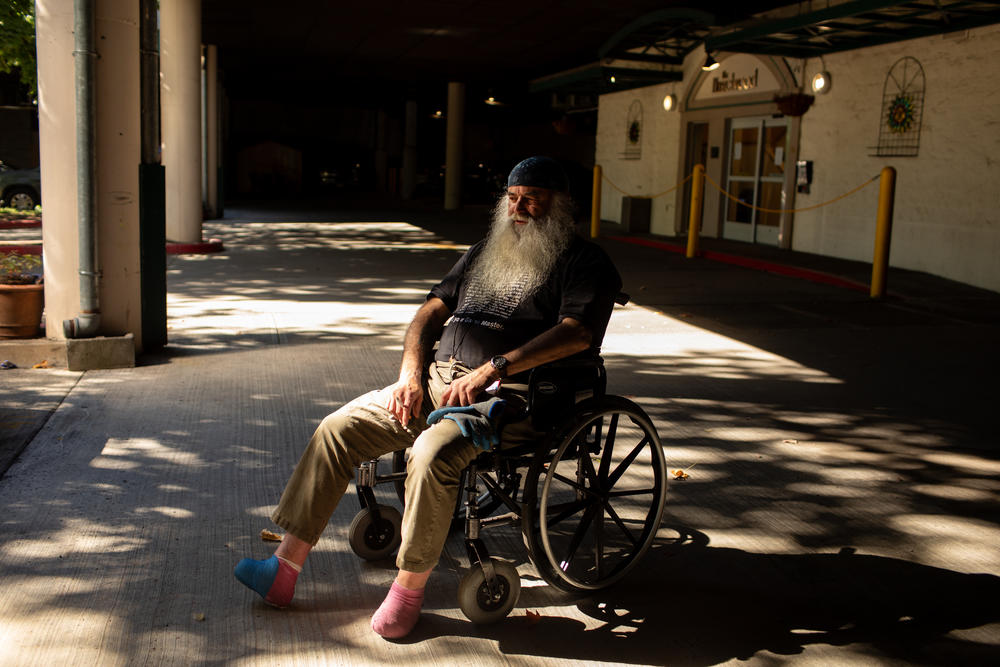Section Branding
Header Content
Can states ease homelessness by tapping Medicaid funding? Oregon is betting on it
Primary Content
Updated October 12, 2023 at 7:13 AM ET
When Ben Norris was living on the street, he had many things to worry about: authorities sweeping his tent, people stealing his belongings, the perils of weather and the hardship of hygiene. There was no room on the list for maintaining his health.
That's how he ended up in the emergency room, unaware he was suffering from diabetes. Norris' toes already had gangrene, and he quickly lost both his feet to the disease. Despite everything, he's been in good spirits lately. Norris has a new apartment, and as he gives a quick tour of the building, he gestures toward the gym he says he doesn't have much use for. "I don't do a lot of treadmilling," he jokes before navigating his wheelchair to his unit.
Norris, 65, is part of a pilot project in Oregon that taps into Medicaid funds. Typically used to pay for things like medical procedures and appointments, Medicaid provides health care for tens of millions of low-income people – more than 1 in 5 Americans. Now, for the first time, it's being used for housing and rent for people who are homeless or in danger of becoming so.
With a $1 billion dollar investment in coming years, Oregon is one of several states betting big on programs like this. Officials hope that by keeping people out of medical crises that lead to repeated and expensive emergency room visits, Oregon will save enough money to pay for increased housing costs.
The money will flow from the state to nonprofit organizations and outreach workers, who will then partner with people like Norris to find and keep housing. Several pilot projects are already underway, and Oregon has the next three years to scale up the effort.
In his apartment, Norris points to rows of medication. He takes five or six a day. Three times a week, he wheels himself a block down the street to a wound care facility where his amputations — still recent — are cared for. This kind of preventative medical regime is much less taxing on the healthcare system than emergency care, and Norris says he never could have maintained it from a tent.
"I might not be alive if it wasn't for this program," he says.
Norris also receives support from an outreach worker, Amy Borton, who on this day unpacks a food box she's brought. It's got things like apples, onions, cereal and potatoes. She helps him navigate medical appointments or just checks in on him. Working together for months, they've built trust. Relationships and support are also critical ingredients for success in helping people stay housed.
"Yeah, I think one of the first things I remember us checking in about when you first moved in here is you kept setting your smoke alarm off with the pork chops," Borton teases Norris.
"Yeah, exactly," he chuckles. "It still goes off. Oh, it drives me nuts, man."
California is already working to implement a program similar to Oregon's, spending more than $100 million a year on housing from its Medicaid budget. With more than 170,000 homeless people, California is at the epicenter of the homeless crisis.
"I know that if I could get my patients who are experiencing homelessness housing, we could make everything else work better," says Margot Kushel, a physician who works on solutions to homelessness at University of California, San Francisco.
Older people are especially at risk. Kushel says she can sometimes guess when a patient has lost housing because after years of stability their health takes a drastic turn. "They're doing well," she says "And suddenly, they come to me and everything has fallen apart."
She's optimistic about California's new program, but she's aware of the many questions it raises around housing supply and affordability for the state.
"So the bet here," Kushel says, "is can we target it and not use Medicaid as a way to provide rent for everybody? But instead use it as a way for people to have less reliance on the most expensive part of our health system?"
Organizations in both California and Oregon that work directly with unhoused people say the Medicaid program could be a game changer. "The stakes are pretty high on this," says Sean Hubert, vice president of Central City Concern in Portland, a nonprofit that works to provide housing and supportive services for people.
The federal government spends roughly $7 billion on homeless assistance compared with more than $700 billion a year on Medicaid. Hubert says access to Medicaid dollars could help organizations like his provide significantly more housing.
"Ultimately, we've got to get those two systems working more closely together," he says.
Several small pilots have borne out promising results. Advocates know this is not a guarantee that savings will pencil out on a larger scale. "In healthcare, we don't actually usually think about good healthcare outcomes as being less expensive," Kushel says.
A better measure of healthcare outcomes is health, she says.
For Ben Norris, that means learning to manage his diabetes.
"Yeah, it's extremely difficult," he says. "If you don't take care of it, you know, you end up not being around."
Who's paying for this lifesaving service — whether Medicaid or something else, he says — doesn't much matter. Diabetes has already taken his feet. He's doing his best not to let it have any more of him.
This story is part of a reporting fellowship sponsored by the Association of Health Care Journalists and supported by The Commonwealth Fund.
Copyright 2023 NPR. To see more, visit https://www.npr.org.




